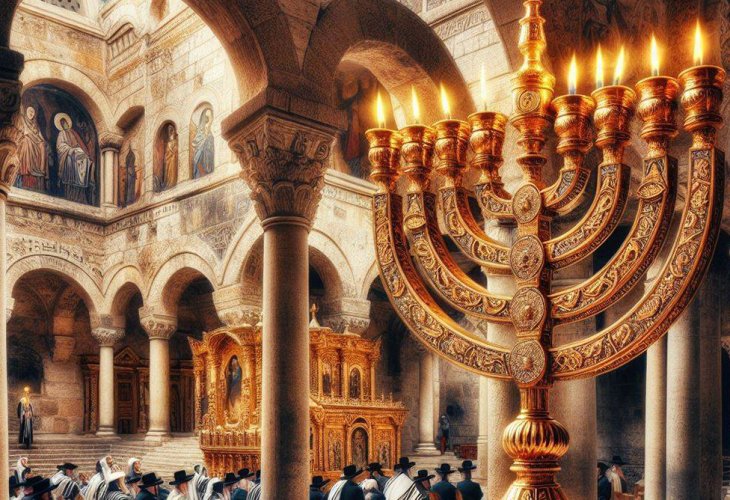From Temple Treasure to Lost Relic: The Journey of the Menorah
The Hasmoneans, upon becoming wealthy, crafted a grand three-cubit golden Menorah, adorned as described in the Torah. This symbol of the Temple and the Jewish people has a rich history. But where is it now?

The golden Menorah crafted by the Babylonian returnees was plundered by the wicked Antiochus. When the Hasmoneans entered the Temple, they couldn't find a Menorah and lacked the gold to make one. Thus, they fashioned a Menorah from seven iron spits. According to Jewish law, if gold isn't available, a Menorah can be made from any material. It was with this simple Menorah that the famous miracle of the oil jug occurred, where one jug lasted eight days.
As the Hasmoneans grew in wealth and power, they crafted an enormous golden Menorah, three cubits in height, crafted from a single piece and adorned with flowers, knobs, and cups, as described in the Torah. This Menorah became a symbol of the Temple and the Jewish people. The sages said, "Those who wish to become wise should turn south – the Menorah is in the south." Since the days of the Temple, the Menorah appears on coins, objects, tombstones, and Jewish symbols worldwide.
So, where is the Menorah now?
Titus the Roman, who destroyed the Second Temple, famously took the Menorah in his victory parade, an event depicted in the relief on the Arch of Titus in Rome, where it remains to this day. The Menorah, along with other Temple artifacts, was housed in a special structure named the 'Temple of Peace.' Our sages, the Tannaim, reported seeing these artifacts in Rome, using their inscriptions to resolve halachic questions, such as how the name of Hashem should be inscribed on the High Priest's forehead plate.
In the fifth century, tribes from the region of Germany invaded Rome several times, looting its treasures. In 410 CE, led by King Alaric I, the Visigoths sacked Rome's temples. Though much is known about their lootings, it is unclear if the Menorah was part of their spoils, especially since an earthquake may have moved the Temple artifacts to another location in Rome. Such destruction fueled Jewish hopes of reclaiming the Temple Menorah, belonging to the Jewish people.
One legend suggests the Menorah was buried with King Alaric I, but others claim the Visigoths spread this rumor to halt searches. Another tale proposes the Menorah was cast into the Tiber River during a battle, questioning who would foolishly throw away a golden treasure.
Medieval writers often claimed the Vandals took the Menorah to Carthage (modern Tunisia). After Carthage fell to the Byzantines, Emperor Justinian allegedly dreamt that as long as he possessed the Jewish Menorah, his empire was in danger. Therefore, he sent it to Jerusalem, where it vanished during a sudden battle with the Persians.
Yet another Jewish legend tells of Justinian noticing a crack in the Menorah's base before sending it to Jerusalem. Not wanting to dispatch a damaged piece, he tasked a Jewish smith with its repair, swearing him to secrecy. The smith shared the secret with the city's rabbi, who advised a daring plan: gather gold donations from the community's wealthy members to craft a perfect replica of the Menorah, handing the imitation to the emperor while keeping the original Menorah safe with the Jews.
Indeed, the smith acted as planned. The fake was sent to Jerusalem under the emperor's orders, and the genuine Menorah stayed with him. Realizing he couldn't hide it forever, and fearing for its safety, the rabbi ordered him to travel to Israel, teaching him special prayers to reveal the correct hiding spot. His journey was fraught with challenges until he reached Jaffa. Renting a camel from the first person he met, he loaded the heavy bundle and set off. The camel walked non-stop until it reached Hebron, eventually stopping and refusing to continue. The smith understood this was the Menorah's hiding place, dug a deep hole, and buried it. He then drove a wooden stake marking the spot to pass the secret to his descendants, hoping it would be revealed during the redemption.
But, as soon as the marker was set, a massive sandstorm arose, forcing him to take shelter. After the storm, he found the landscape unrecognizable, with no camel, marker, or familiar surroundings. He wandered through the night until he reached a Bedouin camp, from which he returned to Jaffa, telling the rabbi, "I have fulfilled your mission, and the Menorah now rests in good hands, the hands of Hashem."

